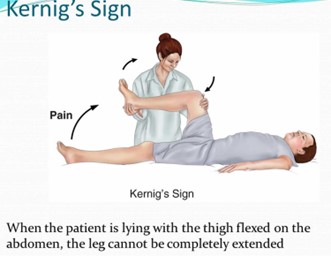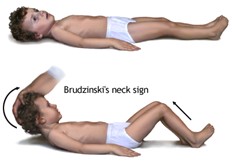A nurse is assessing a client who reports a severe headache and stiff neck. The nurse's assessment reveals positive Kernig's and Brudzinski's signs. Which of the following actions should the nurse perform first?
Decrease bright lights.
Initiate IV access.
Administer antibiotics.
Implement droplet precautions.
The Correct Answer is D
Choice A reason: Decreasing bright lights is an appropriate action for a nurse to take when caring for a client who has signs of meningitis, as it helps to reduce the photophobia (sensitivity to light) and headache that are common symptoms of the condition. However, this action is not the first priority, as it does not prevent the transmission of the infection or treat the underlying cause.
Choice B reason: Initiating IV access is an appropriate action for a nurse to take when caring for a client who has signs of meningitis, as it facilitates the administration of fluids, medications, and blood products that may be needed to manage the condition. However, this action is not the first priority, as it does not prevent the transmission of the infection or treat the underlying cause.
Choice C reason: Administering antibiotics is an appropriate action for a nurse to take when caring for a client who has signs of meningitis, as it helps to treat the bacterial infection that is the most common cause of the condition. However, this action is not the first priority, as it requires a prescription from the health care provider and confirmation of the diagnosis by laboratory tests such as blood culture or cerebrospinal fluid analysis.
Choice D reason: Implementing droplet precautions is the first priority action for a nurse to take when caring for a client who has signs of meningitis, as it helps to prevent the spread of the infection to other clients and staff members. Droplet precautions are a type of isolation precautions that are used for infections that are transmitted by respiratory droplets, such as meningitis, influenza, and pertussis. Droplet precautions involve wearing a surgical mask when entering the client's room, placing the client in a private room or cohorting with other clients who have the same infection, and limiting visitors and staff contact with the client.


Nursing Test Bank
Naxlex Comprehensive Predictor Exams
Related Questions
Correct Answer is D
Explanation
Choice A reason: Decreasing bright lights is an appropriate action for a nurse to take when caring for a client who has signs of meningitis, as it helps to reduce the photophobia (sensitivity to light) and headache that are common symptoms of the condition. However, this action is not the first priority, as it does not prevent the transmission of the infection or treat the underlying cause.
Choice B reason: Initiating IV access is an appropriate action for a nurse to take when caring for a client who has signs of meningitis, as it facilitates the administration of fluids, medications, and blood products that may be needed to manage the condition. However, this action is not the first priority, as it does not prevent the transmission of the infection or treat the underlying cause.
Choice C reason: Administering antibiotics is an appropriate action for a nurse to take when caring for a client who has signs of meningitis, as it helps to treat the bacterial infection that is the most common cause of the condition. However, this action is not the first priority, as it requires a prescription from the health care provider and confirmation of the diagnosis by laboratory tests such as blood culture or cerebrospinal fluid analysis.
Choice D reason: Implementing droplet precautions is the first priority action for a nurse to take when caring for a client who has signs of meningitis, as it helps to prevent the spread of the infection to other clients and staff members. Droplet precautions are a type of isolation precautions that are used for infections that are transmitted by respiratory droplets, such as meningitis, influenza, and pertussis. Droplet precautions involve wearing a surgical mask when entering the client's room, placing the client in a private room or cohorting with other clients who have the same infection, and limiting visitors and staff contact with the client.


Correct Answer is C
Explanation
Choice A reason: A skilled nursing facility is a type of long-term care facility that provides 24-hour nursing care and supervision for residents who need assistance with activities of daily living, such as bathing, dressing, eating, and toileting. A skilled nursing facility may not be suitable for a young client with multiple sclerosis who has the potential for improvement and recovery.
Choice B reason: Home care services are a type of community-based care that provides medical and personal care to clients in their own homes. Home care services may include nursing, physical therapy, occupational therapy, speech therapy, social work, or home health aide services. Home care services may be appropriate for a client with multiple sclerosis who has mild to moderate symptoms and a supportive family or caregiver.
Choice C reason: A rehabilitation facility is a type of short-term care facility that provides intensive physical and occupational therapy to clients who have functional impairments due to injury, illness, or surgery. A rehabilitation facility may also provide medical, nursing, and psychological care to clients who need them. A rehabilitation facility may be suitable for a client with multiple sclerosis who has significant muscle weakness and needs to regain strength, mobility, and independence.
Choice D reason: A sub-acute care facility is a type of transitional care facility that provides medical and nursing care to clients who are stable but need complex monitoring or treatment that cannot be provided at home or in a skilled nursing facility. A sub-acute care facility may also provide rehabilitation services to clients who need them. A sub-acute care facility may not be appropriate for a young client with multiple sclerosis who has the potential for improvement and recovery.

Whether you are a student looking to ace your exams or a practicing nurse seeking to enhance your expertise , our nursing education contents will empower you with the confidence and competence to make a difference in the lives of patients and become a respected leader in the healthcare field.
Visit Naxlex, invest in your future and unlock endless possibilities with our unparalleled nursing education contents today
Report Wrong Answer on the Current Question
Do you disagree with the answer? If yes, what is your expected answer? Explain.
Kindly be descriptive with the issue you are facing.
